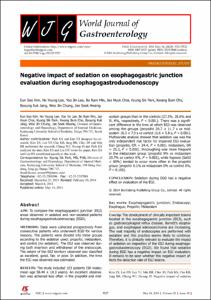KUMEL Repository
1. Journal Papers (연구논문)
1. School of Medicine (의과대학)
Dept. of Internal Medicine (내과학)
Negative impact of sedation on esophagogastric junction evaluation during esophagogastroduodenoscopy
- Keimyung Author(s)
- Kim, Eun Soo; Lee, Yoo Jin; Park, Kyung Sik; Cho, Kwang Bum; Jang, Byoung Kuk; Chung, Woo Jin; Hwang, Jae Seok
- Department
- Dept. of Internal Medicine (내과학)
- Journal Title
- World Journal of Gastroenterology
- Issued Date
- 2014
- Volume
- 20
- Issue
- 18
- Keyword
- Esophagogastric junction; Endoscopy; Esophagus; Propofol; Midazolam
- Abstract
- AIM: To compare the esophagogastric junction (EGJ) areas observed in sedated and non-sedated patients during esophagogastroduodenoscopy (EGD).
METHODS: Data were collected prospectively from consecutive patients who underwent EGD for various reasons. The patients were divided into three groups according to the sedation used: propofol, midazolam, and control (no sedation). The EGJ was observed during both insertion and withdrawal of the endoscope. The extent of the EGJ territory observed was classified as excellent, good, fair, or poor. In addition, the time the EGJ was observed was estimated.
RESULTS: The study included 103 patients (50 males; mean age 58.44 ± 10.3 years). An excellent observation was achieved less often in the propofol and midazolam groups than in the controls (27.3%, 28.6% and 91.4%, respectively, P < 0.001). There was a significant difference in the time at which EGJ was observed among the groups (propofol 20.7 ± 11.7 s vs midazolam 16.3 ± 7.3 s vs control 11.6 ± 5.8 s, P < 0.001). Multivariate analysis showed that sedation use was the only independent risk factor for impaired EGJ evaluation (propofol, OR = 24.4, P < 0.001; midazolam, OR = 25.3, P < 0.001). Hiccoughing was more frequent in the midazolam group (propofol 9% vs midazolam 25.7% vs control 0%, P = 0.002), while hypoxia (SaO2 < 90%) tended to occur more often in the propofol group (propofol 6.1% vs midazolam 0% vs control 0%, P = 0.101).
CONCLUSION: Sedation during EGD has a negative effect on evaluation of the EGJ.
Keywords: Esophagogastric junction, Endoscopy, Esophagus, Propofol, Midazolam
Core tip: The development of clinically important lesions located in the esophagogastric junction (EGJ), such as gastroesophageal reflux disease, Barrett’s esophagus, and esophageal adenocarcinoma are increasing. The vast majority of endoscopies are performed with sedation and this practice seems likely to continue. Therefore, it is clinically relevant to evaluate the impact of sedation on inspection of the EGJ during esophagogastroduodenoscopy (EGD). We found that sedation during EGD has a negative impact on EGJ evaluation. It remains to be seen whether this negative impact affects the detection rate of EGJ lesions.
- Publisher
- School of Medicine
- Citation
- Eun Soo Kim et al. (2014). Negative impact of sedation on esophagogastric junction evaluation during esophagogastroduodenoscopy. World Journal of Gastroenterology, 20(18), 5527–5532. doi: 10.3748/wjg.v20.i18.5527
- Type
- Article
- ISSN
- 1007-9327
- Appears in Collections:
- 1. School of Medicine (의과대학) > Dept. of Internal Medicine (내과학)
- 파일 목록
-
-
Download
 oak-aaa-5142.pdf
기타 데이터 / 1.28 MB / Adobe PDF
oak-aaa-5142.pdf
기타 데이터 / 1.28 MB / Adobe PDF
-
Items in Repository are protected by copyright, with all rights reserved, unless otherwise indicated.